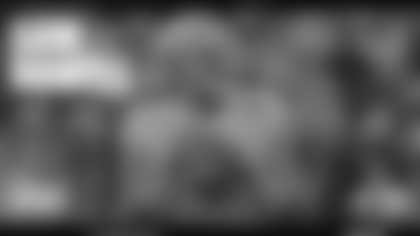He was a quiet leader who played games in total silence. Trash talking and showboating were antithetical to his approach, for he embodied professionalism and carried himself with dignity on the field.
Art Monk's goal was simple: Let his achievements do the talking.
And boy, did they.
Monk is one of the premier wide receivers in NFL history. In 16 seasons, he caught 940 passes for 12,721 yards (13.5 average) and 68 touchdowns, retiring as the league's leader in total receptions; he has since been surpassed by a host of receivers.
He set all-time NFL marks for most catches in one season (106 in 1984) and most consecutive games with receptions (183), both of which have been broken, and owns a slew of Redskin receiving records.
As Monk tells it, his silence was golden.
"I've had guys say stuff to me and look me right in the eye and try to intimidate me," Monk told Washingtonian magazine in 1988. "But I just go back to the huddle and say, 'I'm going to catch this one, and after I catch it maybe I can run over him.' I found that I excel more in those situations than when someone doesn't say anything to me."
Monk, a three-time Pro Bowler and two-time All-Pro, was selected to the Pro Football Hall of Fame class of 2008 on Saturday, Feb. 2. He was a finalist for induction eight times since becoming eligible in 2001.
"I don't think there's another guy who deserves it more than him," said Don Warren, a tight end who teamed with Monk for 13 seasons in Washington and a current Redskins scout. "He was a guy who helped the Redskins out tremendously."
Monk's art of pass catching was instrumental in propelling the Redskins' glory teams of the 1980s and early-1990s. He was on the roster for each of the squad's four Super Bowl appearances during the era, earning three rings.
The legend also became one of the most beloved Redskins ever, as amplified by his selection as the best player in team history in the 50th anniversary "Greatest Redskins Poll" in 1986.
He received 8,469 votes from fans, topping two Hall of Famers in running back John Riggins (8,154) and quarterback Sonny Jurgensen (8,069). Fans at RFK Stadium named a section after him called the "ART GALLERY."
When asked about his 16-year career, the modest and soft-spoken Monk replied: "I wouldn't have changed a thing. I came in not expecting anything and not even to really last very long in the NFL.
"I didn't think I was even talented enough to play on this level but ended up playing a long time and having a great career. I couldn't have asked for anything better."
Raised in the New York City suburb of White Plains, N.Y., Monk starred in track and football in high school and came to admire such dominant pro receivers as the Redskins' Charley Taylor, Otis Taylor and Paul Warfield.
He received a football scholarship to Syracuse, where he set school receiving records with 102 catches for 1,644 yards and had more than 1,000 yards in both rushing and returning kicks.
Then-Redskins General Manager Bobby Beathard was sold on Monk after scouting him.
"He was a fabulous athlete, a very smart young guy," Beathard said. "He was a good worker, he had speed, he was smooth, great hands, he was a guy who loved to play pro football. I don't think Art Monk was a really hard guy to figure out or scout."
To Beathard, Monk was more of a receiver than a running back, and the Redskins took him in the first round in 1980 (18th overall), their first first-round pick since 1968.
Monk, a starter by the fourth game, caught a team-high 58 passes for 797 yards and three TDs that season, breaking the club's rookie receiving record set in 1964 by none other than Charley Taylor. He was a unanimous All-Rookie selection.
At the same time, the 6-3, 210-pound Monk was drawing comparisons to Taylor, who had similar size and was just as physical.
"People talked a lot about me falling in his footsteps when I got here, and that in itself was an honor," Monk said. "But really I just wanted to be myself. I didn't want to pattern myself after anybody. I had my own style and my own way of doing things. But he was an idol, and I looked up to him growing up."
Monk averaged 49 catches and 721 receiving yards and made 14 TD catches in his first four seasons, which were slightly abbreviated because of injuries.
One injury forced him to miss the 1982 postseason that ended with the Redskins' win in Super Bowl XVII. (Monk had never missed a game or a practice because of injury in his four years at Syracuse.)
But he crafted a historic season in his fifth year, 1984, catching an NFL-record 106 passes for a career-high 1,372 yards and seven TDs. He broke the record in the season-finale against the Cardinals.
Needing seven catches to top the record of 101 set by the Houston Oilers' Charlie Hennigan in 1964, Monk caught 11. His last reception, a 20-yarder on 3rd-and-19, helped set up a field goal that gave the Redskins a 29-27 victory and the NFC East title. No wonder Monk's nickname was "money."
Monk was a consensus first-team All-Pro that year and received his first Pro Bowl invitation. He also made the Pro Bowl in 1985 and 1986. The latter year, he became the first Redskin receiver to record three straight 1,000-yard and 70-plus catch seasons.
All the while, No. 81 proved he was more substance than style, never one to be confused with his flashy teammate, receiver Gary Clark. His trademark pass pattern was the "dodge" route, a short route over the middle.
Monk possessed the size, power and toughness to execute the pattern, maneuvering through traffic and fending off linebackers and other defenders. He could also gain big yardage after the catch.
Monk rarely spoke to teammates or reporters. But when he spoke up in team meetings, other Redskins shut up in what coach Joe Gibbs once described as an "E.F. Hutton moment."
His commitment to improve his strength and physical conditioning also spoke volumes, for he followed a rigorous workout plan that made his teammates envious. He filled his days with demanding combinations of weight lifting, wind sprints, distance running and racquetball.
He often ran grueling sprints on a 45-degree, 15-yard hill, in one workout running 25 times uphill with straight leg-pumps, then 25 times backward, then 25 times in a stutter-step. He added six 220-meter sprints and six 110-meter sprints.
Monk credited Terry Metcalf, a running back who played for the Redskins in 1981, with inspiring him to pursue such a grueling routine.
"(Metcalf) was a fanatic with training and staying in shape," Monk said. "I just caught on and maintained that for the rest of my career. It wasn't just an in-season thing, it was during the off-season, a full-time thing: hills, biking, weights, track, agility, cardiovascular, just a combination of things."
As for Monk, "He was huge for a wide receiver, he could run, he had great hands, he was very physical, he had the talent, and he had the work ethic," Don Warren said. "I kind of molded myself a little after him, just watching the way he worked out. We spent many summers running sprints on the track. He's one of the hardest workers."
Former Redskin quarterback Joe Theismann: "Art is as tough as any player I've ever played with and had every attribute you'd want to look for. If you were putting together a football team and fashioned it after a bunch of Art Monks, you'd win a lot of football games."
On Oct. 12, 1992, Monk's became the league's all-time leading receiver in a Monday night game against Denver, making his 820th reception to top Seahawks great Steve Largent.
By the end of the 1993 campaign, he had posted nine seasons of 50 or more catches and five with at least 1,000 yards.
But Monk and the Redskins fell into a contract dispute, and he departed acrimoniously. The next two seasons, he caught 46 passes for 581 yards and three TDs with the Jets, and six balls for 114 yards with the Eagles.
After failing to sign with a team for the 1996 season, Monk retired from the game in June 1997. The Redskins immediately announced plans to sign him to a ceremonial one-day contract so he could retire as a member of the burgundy and gold.
"Nothing would delight us more than for Art Monk to officially retire as a Redskin," then-Redskins President John Kent Cooke said. "We look forward to signing Art one more time so he can go into the Hall of Fame as a Washington Redskin."
Added Monk: "I'll always consider myself a Redskin."
Michael Richman is the author of The Redskins Encyclopedia, a 432-page book that spans the 75-year history of the storied franchise. His Web site is www.redskinshistorian.com.





